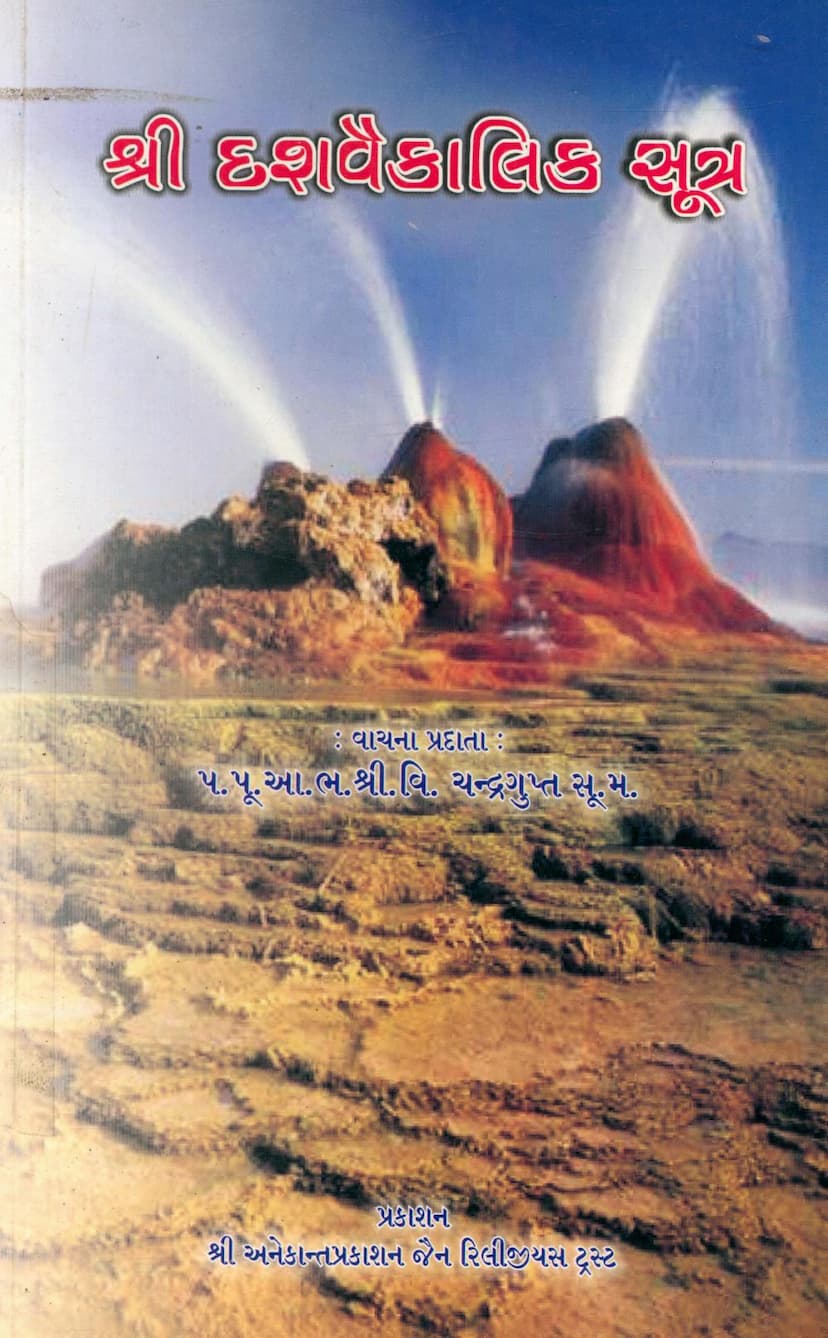Dashvaikalik Sutra
Added to library: September 1, 2025

Summary
Here is a comprehensive summary in English of the provided Jain text, "Dashvaikalik Sutra" (specifically covering the initial sections and introductory discourse):
The text begins by emphasizing that the sole purpose of the teachings of the omniscient Arihants is to guide beings towards liberation from the cycle of worldly existence. It introduces the "Dashvaikalik Sutra" as a profound scripture composed by Acharya Shyyambhava Suri, a Chodpurvi (possessor of fourteen Purvas), which is destined to endure until the end of the current era (Pancham Kal). Despite the anticipated decline of scriptural knowledge in this era, this Sutra is expected to remain. The text highlights the immense fortune of being able to hear and understand this Sutra, especially as it is accessible to lay followers (Shravaks) for four of its ten chapters.
The primary purpose of making this Sutra accessible to lay followers is to foster within them a constant aspiration towards the ideal of monkhood (Sadhu-pana). True lay discipleship, it is argued, stems from a heart that understands that ultimate well-being lies only in the path of a monk. Those who have love for the monastic life and a desire to become monks are always eager to hear about their conduct. The text defines a Shravak as one who observes the vows of lay life and listens to the conduct of monks with the aspiration of eventually embracing monkhood. This right is not for those who have no desire to become monks and choose to remain householders by choice.
Key Themes and Discussions:
- The Goal of Liberation: The overarching aim of Jain philosophy is to achieve liberation from the cycle of birth and death.
- The Importance of Monkhood: The monastic life is presented as the most direct and fundamental path to liberation.
- Aspiration vs. Action: The text stresses the importance of not just having the desire for monkhood but actively striving for it. It criticizes the modern tendency to want religious merit without embracing the rigorous path of a monk.
- The Gradual Path: It outlines the spiritual progression: from foundational understanding (Marganusari-pana) to right faith (Samyaktva), partial renunciation (Deshvirati), complete renunciation (Sarvavirati), and ultimately to detachment (Vitraagta).
- The Role of Grihasthas (Householders): While the Sutra primarily addresses monks, its teachings are relevant to householders. A householder who aspires for liberation should cultivate a desire for monkhood and strive to understand its principles, even while living a householder's life. A householder's devotion, without this aspiration, may become mere physical exertion and yield limited results.
- The Importance of Desire for Monkhood: The text argues that even in old age, the desire for liberation and the monastic path should remain vital. It contrasts this with the persistent desire for worldly comforts like food, even when the body is weak. The aspiration for liberation and monkhood is presented as the true basis of life for a spiritual seeker.
- The Composition of the Dashvaikalik Sutra: The text delves into the historical context of the Sutra's creation. It was composed by Acharya Shyyambhava Suri for his son, Manak Muni, who had a short lifespan. The Sutra's creation was motivated by the need to provide a comprehensive guide to monastic conduct, especially for the last part of the era. The lineage of its transmission is highlighted, mentioning Acharya Bhadrabahu Swami (Niyukti) and Acharya Jinabhadra Gani Kshamashraman (Bhashya), with commentaries by Acharya Haribhadra Suri.
- The Story of Shyyambhava: A significant portion of the introduction narrates the story of Shyyambhava, a Brahmin who was initiated into Jainism by Acharya Prabhava Swami. Shyyambhava, initially a scholar of Vedic traditions, questioned the truth of his teacher's teachings after hearing the Jain monks' words at a sacrifice. His eventual understanding of the truth led him to embrace Jainism, and he later became a fourteen-Purva holder. This story underscores the importance of questioning, seeking truth, and the transformative power of right knowledge.
- The Decline of Values: The narrative also includes a critical reflection on the present-day state of Jain followers, lamenting a perceived decline in adherence to truthfulness and integrity, contrasting it with the high regard Jain monks once commanded. It questions whether the current generation truly upholds the principles of non-deception and the purity of scriptural interpretation.
- The Significance of Manak Muni: The story of Manak Muni, the young son of Shyyambhava, who attained immense spiritual attainment in a short span after his initiation, serves as a powerful example of dedication and the potential for rapid spiritual progress when motivated by genuine aspiration and guided by a capable Guru.
- The Nature of True Spirituality: The discourse repeatedly emphasizes that spirituality is not merely about performing rituals or acquiring knowledge but about embodying the principles of conduct (Achar), which are rooted in non-violence (Ahimsa), self-restraint (Sanyam), and austerity (Tapa). True spirituality is defined as detachment from worldly desires and a commitment to the path of liberation, regardless of personal comfort or hardship.
- The Importance of the Guru: The text implicitly and explicitly highlights the crucial role of the Guru in guiding the disciple, not just in acquiring knowledge but in purifying conduct and cultivating the right attitude towards spiritual practice.
In essence, the introductory parts of the Dashvaikalik Sutra, as presented in this text, serve as a prologue that sets the stage for the detailed discussions on monastic conduct. It aims to inspire the audience, particularly lay followers, to cultivate a sincere aspiration for monkhood, understand the principles of the Jain path, and strive for spiritual purity through the diligent practice of Ahimsa, Sanyam, and Tapa, as exemplified by the great monks of the past. The narrative is infused with moral reflections and warnings against complacency and the dilution of spiritual ideals in the current era.